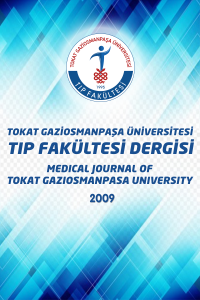Atlas Ark Anomalilerinin Bilgisayarlı Tomografi ile Değerlendirilmesi
Amaç: Bu çalışmada çeşitli nedenlerle servikalspinal aksa yönelik bilgisayarlı tomografi (BT) tetkiki yapılmış hastalarda atlasın posterior ark defektlerinin sıklığı ve tipleri değerlendirilmektedir. Gereç ve Yöntem: Çalışmaya başta travma olmak üzere servikal disk hernisi, spondiloartroz, boyun ağrısı gibi nedenlerle servikal BT tetkiki uygulanan toplam 328 hastadan atlas arkı değerlendirilen 304 hasta (181 erkek, 123 kadın) dahil edildi. Atlasın posterior arkı 5 farklı tip üzerinden incelendi. Posterior ark defektlerine eşlik eden diğer anomalilerde araştırıldı. Bulgular: Atlasın posterior arkı değerlendirmeye alınan hastaların yaş aralığı 10-97 yıl (ortalama 44.7±20.2 yıl) aralığında değişmekteydi. Hastaların 32 (%10.5)’sinde atlasın posterior arkında konjenital anomali saptandı. Bunların 28 (%9.2)’inde tip A defekt, üçünde (%0.9) hem anterior hem de posterior arkta (bipartit atlas) defekt, birinde (%0.3) ise irregüler posterior ark vardı. Tip B, C, D ve E defektler ise saptanmadı. Tip A defekti olan bir hastada aynı zamanda 6. Servikal vertebrada bir diğer hastada ise 2. servikal vertebra spinöz proçeşte spondiloşizis saptandı. Sonuç: Çalışmamızda atlas ark anomalilerine literatürde belirtilenden daha sık karşılaşılabileceği görülmektedir.
Anahtar Kelimeler:
Bilgisayarlı tomografi, Posterior ark defekti, Servikal vertebra, Spondiloşizis
Evaluation of Atlas Arch Anomalies by Computerized Tomography
Objective: In this study, the frequency and types of atlas posterior arch defects were evaluated in computerized tomography examinations of cervical spinal axis for various reasons. Materials and Methods: The study included 304 patients (181 men, 123 women) with a total of 328 patients who underwent cervical CT scans for trauma, including cervical disc herniation, spondyloarthrosis, and neck pain. The atlas posterior arch was studied on five different types. Other anomalies associated with posterior arch defects were investigated. Results: The age range of the atlas posterior arch evaluations ranged from 10-97 years (mean 44.7±20.2 years). Congenital anomaly was detected posteriorly in 32 (10.5%) of the patients. Of these, 28 (9.2%) were indent type A defects, three (0.9%) were both anterior and posterior arch (bipartite atlas) defects and one (0.3%) were irregular posterior arch. Type B, C, D and E defects were not detected. In a patient with type A defect, a 6th cervical vertebra and another a second cervical vertebra spinous process spondylosis were detected. Conclusion: Atlas arch anomalies may be encountered more frequently in our study than those reported in the literature
- ISSN: 1309-3320
- Başlangıç: 2009
- Yayıncı: Tokat Gaziosmanpaşa Üniversitesi
Sayıdaki Diğer Makaleler
Yağ Embolisi Sendromu Olgu Sunumu
Hakan TAPAR, Tuğba KARAMAN, Serkan DOĞRU, Yakup BORAZAN, Gülşen Genç TAPAR
Kas İskelet Sistemi Tümörleri Biyopsisinde Güncel Yaklaşım: Literatürün Gözden Geçirilmesi
Orhan BALTA, Mehmet Burtaç EREN, Kürşad AYTEKİN, Murat AŞÇI, Recep KURNAZ, Bora BOSTAN
Sol Mastoid Kemikte Monostotik Fibröz Displazili Bir Olgunun MRG Bulguları
İsmail OKAN, Zeki ÖZSOY, Mustafa SÜREN, Mustafa ŞAHİN
Mehmet KÖKSAL, Recep ERÖZ, Nurhan CÜCER
Serkan GÜRGÜL, Coşar UZUN, Nurten ERDAL
Atlas Ark Anomalilerinin Bilgisayarlı Tomografi ile Değerlendirilmesi
